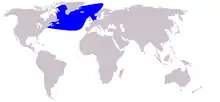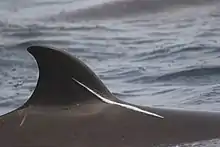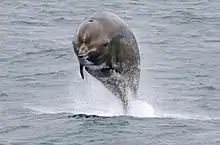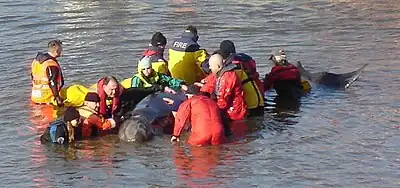| Northern bottlenose whale | |
|---|---|
 | |
 | |
| Size compared to an average human | |
| Scientific classification | |
| Domain: | Eukaryota |
| Kingdom: | Animalia |
| Phylum: | Chordata |
| Class: | Mammalia |
| Order: | Artiodactyla |
| Infraorder: | Cetacea |
| Family: | Ziphiidae |
| Genus: | Hyperoodon |
| Species: | H. ampullatus |
| Binomial name | |
| Hyperoodon ampullatus (Forster, 1770) | |
 | |
| Northern bottlenose whale range (now out of date - see IUCN map below) | |
The northern bottlenose whale (Hyperoodon ampullatus) is a species of beaked whale in the ziphiid family, being one of two members of the genus Hyperoodon. The northern bottlenose whale was hunted heavily by Norway and Britain in the 19th and early 20th centuries. It is one of the deepest-diving mammals known, reaching depths of 2,339 m (7,674 ft)[3] and capable of diving for up to 130 minutes.[4]
Description


When physically mature, northern bottlenose whales can reach 9.8 metres (32 ft) in length,[5] smaller than giant beaked whales, and larger than known records of southern bottlenose whales. Their foreheads, or melons are sexually dimorphic, so that mature males have larger melons, which are flattened or square shape, while mature females and juveniles have rounder melons.[6] Melon coloration can vary, though it appears the head of most males becomes more white or buff colored with age. The beak is not as long as other beaked whale species, and only mature males have two small teeth, which erupt at the front end of the bottom jaw, but are not easily seen.[6] Females also have teeth, but they are buried in the jaw and do not erupt. The dorsal fin is relatively small, at 30–38 centimetres (12–15 in) and about two thirds of the way back on their bodies. It is falcate (sickle-shaped) and usually pointed. The back is mid-to-dark grey with a lighter underside. They weigh approximately 5,800–7,500 kilograms (12,790–16,530 lb).[7][8] The oldest recorded age, determined by counting annual growth layers from a tooth in a whaled specimen was 37. Calves have prolonged weaning and nursing continues until juveniles are 3–4 years old.[9] Males become sexually mature between 7 and 11 years old, females between 8 and 12 years old.[10] They live in ocean areas deeper than 6,500 feet.[11]
Behaviours


Unlike many species of beaked whale, northern bottlenose whales are known to approach and appear curious about vessels, which made them relatively easy targets for whale hunters. However they have demonstrated avoidance to certain sounds such as those emitted by naval sonar in controlled dose response studies.[12][3]
Underwater recordings have found that northern bottlenose whales produce regular high frequency clicks in click trains,[13] which have a characteristic frequency modulated pulse or "upsweep", commonly found in other species of beaked whales.[14] Northern bottlenose whales live in social groups, and are typically found at the surface in groups of 4 to 20.[15][10]
Feeding
Northern bottlenose feed mainly on deep water squid, primarily Gonatus sp., and bottom fish, such as Greenland halibut.[16] Foraging dives can last an hour or more at depths reaching over 1000 meters.[17] A small percentage of northern bottlenose whales have also been observed feeding on redfish, rabbitfish, spiny dogfish, and skate.[10]
Population and distribution
The northern bottlenose whale is endemic to the North Atlantic Ocean and populations are found in the deep (>500 m) cold subarctic waters of the Davis Strait, the Labrador Sea, the Greenland Sea and the Barents Sea, but can range as far south as Newfoundland and Nova Scotia. As of 2017, the population in the North East Atlantic is estimated to be between 10,000 and 45,000. However their population number is very poorly understood.[10][18]
"The Gully", a large submarine canyon east of Nova Scotia, is the home of the "Scotian Shelf" population of 164 whales, currently listed under Canada's Species at Risk Act as endangered. This population is the focus of a long-term research project conducted by the Whitehead Lab, at Dalhousie University since 1988.[19]
In 1976 the Scientific Committee of the International Whaling Commission identified a single population across the North Atlantic. In 2011 COSEWIC determined that there are two populations off eastern Canada (Scotian Shelf and Labrador-Davis Strait Designated Units), which recent studies have confirmed are genetically distinct from each other.[20][21] Individual northern bottlenose whales have also been sighted off the Azores and Canary Islands.
Extant (resident) as per IUCN Redlist November 2020
Canada; Faroe Islands; France; Germany; Greenland; Iceland; Ireland; Netherlands; Norway; Portugal; Spain; Svalbard and Jan Mayen; Sweden; United Kingdom; United States
Presence Uncertain as per IUCN Redlist November 2020
Denmark; Mauritania; Morocco; Russian Federation; Western Sahara
On 20 January 2006, a female northern bottlenose whale was spotted in Central London in the River Thames.[22] The River Thames whale reached as far up river as Albert Bridge. She was moved onto a barge and rescuers hoped to take her out to sea, but she died following a convulsion on 21 January during its rescue. Her skeleton is now in the Natural History Museum in London.[23]
There was another sighting on 6 August 2019 at Loch Linnhe, a sea loch located off the West coast of Scotland.[24] At the time it was thought to be searching for food in the area. There have been 21 previous live sightings of the northern bottlenose whale in Scotland since 2000. It is speculated that these whales may migrate to north west European shelf waters in the summertime.
On 1 October 2020 a rescue group ushered a group of northern bottlenose whales out of Loch Long, north of Glasgow, it is speculated that these whales moved to shallow water in response to a military sonar exercises.[25]

History of discovery
It was first described by Johann Reinhold Forster in 1770, basing the name on the "bottle-nosed whales" seen by Pehr Kalm in his Travels into North America, and on Thomas Pennant's 1766 description of Samuel Dale's "bottle-head whale" found stranded above a bridge in Maldon, Essex, in 1717.
Conservation
Prior to the beginning of whaling, it is estimated that there were upwards of 100,000 northern bottlenose whales in the North Atlantic.[19] Between 1850 and 1973, commercial hunting of the species, focused on populations found off Norway, Iceland, Greenland and Labrador, greatly reduced their numbers across their range. Current conservation concerns include threats from human activities such as disturbance related to offshore oil and gas developments and naval sonar, as well as entanglement in fishing gear, pollution, ingestion of plastic and ecosystem shifts related to climate change.[19][26]
The International Whaling Commission designated the northern bottlenose whale as a protected stock in 1977 and set a zero catch quota.[27] Northern bottlenose whales are still killed in the Faroe Islands. Faroese regulations only allow the killing of bottlenose whales which have beached themselves and cannot be driven out again.[28] Long term statistics indicate that the most frequent beachings are in the villages of Hvalba and Sandvík on Suðuroy.[28]
The northern bottlenose whale is listed under Canada's Species at Risk Act as endangered, as near threatened under the IUCN red list and on Appendix II[29] of the Convention on the Conservation of Migratory Species of Wild Animals (CMS).[30] In addition, the northern bottlenose whale is covered by the Agreement on the Conservation of Small Cetaceans of the Baltic, North East Atlantic, Irish and North Seas (ASCOBANS).[31]
The northern bottlenose whale has among the lowest known mitochondrial diversity of any cetacean.[20] Due to their low genetic diversity and slow reproductive rate, recovery of their populations may be vulnerable to human stressors and stochastic events.
See also
References
- ↑ Whitehead, H., Reeves, R., Feyrer, L. & Brownell Jr., R.L. (2021). "Hyperoodon ampullatus". IUCN Red List of Threatened Species. 2021: e.T10707A50357742. doi:10.2305/IUCN.UK.2021-1.RLTS.T10707A50357742.en. S2CID 242556890.
{{cite journal}}: CS1 maint: multiple names: authors list (link) - ↑ "Appendices | CITES". cites.org. Retrieved 14 January 2022.
- 1 2 Miller, Patrick (2015). "First indications that northern bottlenose whales are sensitive to behavioural disturbance from anthropogenic noise". Royal Society Open Science. 2 (6): 140484. Bibcode:2015RSOS....240484M. doi:10.1098/rsos.140484. PMC 4632540. PMID 26543576.
- ↑ Wensveen, Paul (2019). "Northern bottlenose whales in a pristine environment respond strongly to close and distant navy sonar signals". Proceedings of the Royal Society B. 286 (1899): 20182592. doi:10.1098/rspb.2018.2592. PMC 6452067. PMID 30890101.
- ↑ "Species Guide - Northern bottlenose whale". Whale and Dolphin Conservation. Retrieved 29 January 2015.
- 1 2 Gowans, Shannon; Rendell, Luke (October 1999). "Head-Butting in Northern Bottlenose Whales (Hyperoodon ampullatus): A Possible Function for Big Heads?". Marine Mammal Science. 15 (4): 1342–1350. doi:10.1111/j.1748-7692.1999.tb00896.x. ISSN 0824-0469.
- ↑ Northern Bottlenose Whale, Hyperoodon ampullatus Archived 18 August 2013 at the Wayback Machine. MarineBio.org
- ↑ Mundinger, G. (2000). Hyperoodon ampullatus. Animal Diversity Web
- ↑ Feyrer (2020). "Prolonged maternal investment in northern bottlenose whales alters our understanding of beaked whale reproductive life history". PLOS ONE. 15 (6): e0235114. Bibcode:2020PLoSO..1535114F. doi:10.1371/journal.pone.0235114. PMC 7310684. PMID 32574188.
- 1 2 3 4 "Northern Bottlenose Whale". NAMMCO. 27 March 2018. Retrieved 23 August 2019.
- ↑ "Northern Bottlenose Whale | NOAA Fisheries". 22 September 2021.
- ↑ Parsons, E.C.M. (2017). "Impacts of Navy Sonar on Whales and Dolphins: Now beyond a Smoking Gun?". Frontiers in Marine Science. 4. doi:10.3389/fmars.2017.00295. ISSN 2296-7745.
- ↑ Clarke, Emma; Feyrer, Laura Joan; Moors-Murphy, Hilary; Stanistreet, Joy (2019). "Click characteristics of northern bottlenose whales (Hyperoodon ampullatus) and Sowerby's beaked whales (Mesoplodon bidens) off eastern Canada". The Journal of the Acoustical Society of America. 146 (1): 307–315. Bibcode:2019ASAJ..146..307C. doi:10.1121/1.5111336. ISSN 0001-4966. PMID 31370599. S2CID 199380113.
- ↑ Stanistreet, Joy E.; Nowacek, Douglas P.; Baumann-Pickering, Simone; Bell, Joel T.; Cholewiak, Danielle M.; Hildebrand, John A.; Hodge, Lynne E.W.; Moors-Murphy, Hilary B.; Van Parijs, Sofie M. (21 February 2017). "Using passive acoustic monitoring to document the distribution of beaked whale species in the western North Atlantic Ocean". Canadian Journal of Fisheries and Aquatic Sciences. 74 (12): 2098–2109. doi:10.1139/cjfas-2016-0503. hdl:1807/78307. ISSN 0706-652X.
- ↑ Gowans, Shannon; Whitehead, Hal; Hooker, Sascha K. (2001). "Social organization in northern bottlenose whales, Hyperoodon ampullatus: not driven by deep-water foraging?". Animal Behaviour. 62 (2): 369–377. doi:10.1006/anbe.2001.1756. ISSN 0003-3472. S2CID 41658723.
- ↑ Hooker, Sascha K; Iverson, Sara J; Ostrom, Peggy; Smith, Sean C (1 August 2001). "Diet of northern bottlenose whales inferred from fatty-acid and stable-isotope analyses of biopsy samples". Canadian Journal of Zoology. 79 (8): 1442–1454. doi:10.1139/z01-096. ISSN 0008-4301.
- ↑ Hooker, Sascha K.; Baird, Robin W. (7 April 1999). "Deep–diving behaviour of the northern bottlenose whale, Hyperoodon ampullatus (Cetacea: Ziphiidae)". Proceedings of the Royal Society of London B: Biological Sciences. 266 (1420): 671–676. doi:10.1098/rspb.1999.0688. PMC 1689818.
- ↑ Whitehead, H; Hooker, SK (7 November 2012). "Uncertain status of the northern bottlenose whale Hyperoodon ampullatus: population fragmentation, legacy of whaling and current threats". Endangered Species Research. 19 (1): 47–61. doi:10.3354/esr00458. ISSN 1863-5407.
- 1 2 3 Whitehead, Hal; Hooker, Sascha K. (7 November 2012). "Uncertain status of the northern bottlenose whale Hyperoodon ampullatus: population fragmentation, legacy of whaling and current threats". Endangered Species Research. 19 (1): 47–61. doi:10.3354/esr00458. ISSN 1863-5407.
- 1 2 Feyrer, Laura Joan; Bentzen, Paul; Whitehead, Hal; Paterson, Ian G.; Einfeldt, Anthony (2019). "Evolutionary impacts differ between two exploited populations of northern bottlenose whale (Hyperoodon ampullatus)". Ecology and Evolution. 9 (23): 13567–13584. doi:10.1002/ece3.5813. ISSN 2045-7758. PMC 6912904. PMID 31871667.
- ↑ "COSEWIC Assessment and Status Report on the Northern Bottlenose Whale in Canada - Species at Risk Public Registry". wildlife-species.canada.ca. Retrieved 29 August 2019.
- ↑ "Whale spotted in central London". BBC. 20 January 2006. Retrieved 30 December 2009.
- ↑ "Lost whale dies after rescue bid". BBC. 21 January 2006. Retrieved 30 December 2009.
- ↑ "Loch Linnhe welcomes rare ocean-going visitor". The Oban Times. 8 August 2019. Retrieved 23 August 2019.
- ↑ "Bottlenose whales shepherded out of Scottish loch ahead of Nato drills". The Guardian. Agence France-Presse. 2 October 2020. ISSN 0261-3077. Retrieved 17 October 2020.
- ↑ Government of Canada, Environment (27 April 2011). "Recovery Strategy for the Northern Bottlenose Whale (Hyperoodon ampullatus), Scotian Shelf population, in Atlantic Canadian Waters - Species at Risk Public Registry". registrelep-sararegistry.gc.ca. Retrieved 27 April 2018.
- ↑ IWC (International Whaling Commission). 1978. Chairman’s report of the Twenty-ninth Meeting. Twenty-eighth Report of the Commission. Cambridge, UK: International Whaling Commission. pp. 18‑27.
- 1 2 Whales around the Faroes. whaling.fo
- ↑ "Appendix II" of the Convention on the Conservation of Migratory Species of Wild Animals (CMS). As amended by the Conference of the Parties in 1985, 1988, 1991, 1994, 1997, 1999, 2002, 2005 and 2008. Effective: 5 March 2009.
- ↑ Hyperoodon ampullatus (Forster, 1770). Convention on Migratory Species page on the northern bottlenose whale
- ↑ Official website of the Agreement on the Conservation of Small Cetaceans of the Baltic, North East Atlantic, Irish and North Seas. ascobans.org
Further reading
- Bottlenose Whales in the Encyclopedia of Marine Mammals Shannon Gowans, 1998. ISBN 0-12-551340-2
- National Audubon Society Guide to Marine Mammals of the World Reeves et al., 2002. ISBN 0-375-41141-0.
- Whales, Dolphins and Porpoises Carwardine, 1995. ISBN 0-7513-2781-6
- Taylor, B.L.; Baird, R.; Barlow, J.; Dawson, S.M.; Ford, J.; Mead, J.G.; Notarbartolo di Sciara, G.; Wade, P.; Pitman, R.L. (2008). "Hyperoodon ampullatus". The IUCN Red List of Threatened Species. 2008: e.T10707A3208523. doi:10.2305/IUCN.UK.2008.RLTS.T10707A3208523.en.
- Beaked Whales in the Animal Encyclopedia: The Definitive Visual Guide David Burnie, 2014. ISBN 978-0-2411-8023-5
External links
 Media related to Hyperoodon ampullatus at Wikimedia Commons
Media related to Hyperoodon ampullatus at Wikimedia Commons Data related to Hyperoodon ampullatus at Wikispecies
Data related to Hyperoodon ampullatus at Wikispecies- Marine Bio: Northern Bottlenose Whale
- Northern Bottlenose Whale
- BBC: Whale spotted in central London
- Whale & Dolphin Conservation Society (WDCS)
- Northern Bottlenose Whale - ARKive bio
- Northern Bottlenose Whale - The Beaked Whale Resource
- Voices in the Sea - Sounds of the Northern bottlenose Whale Archived 9 July 2014 at the Wayback Machine
- IUCN Redlist - Northern Bottlenose Whale
